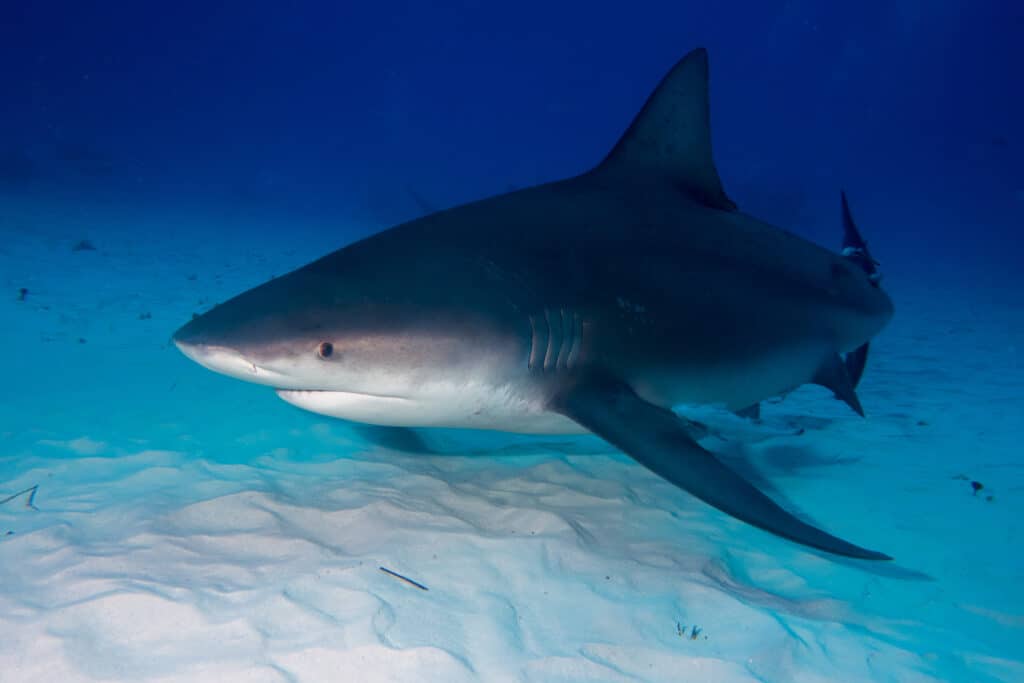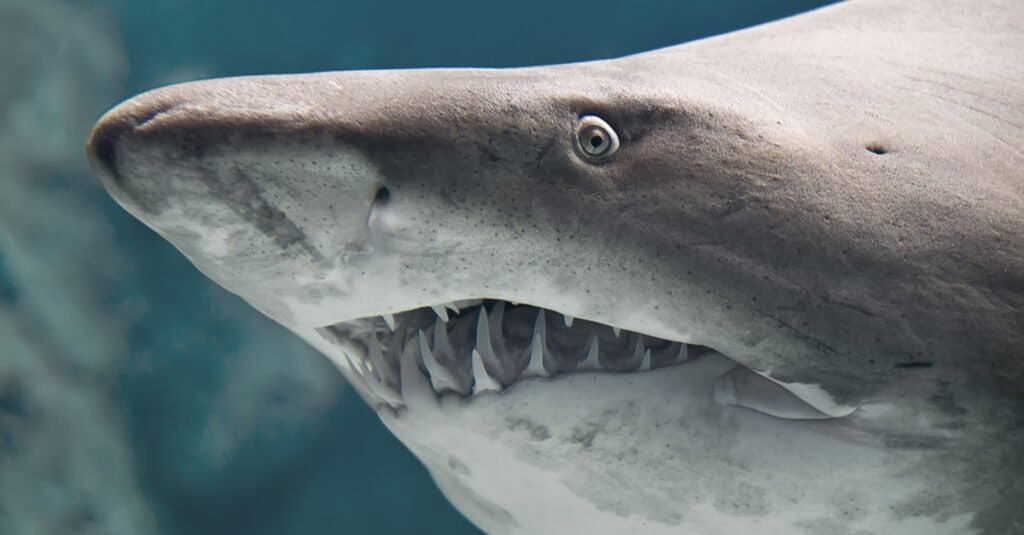The ocean is home to many wonderful and unique animals. Deep underwater there are many fascinating battles which go on where we can’t see them. Some of the most terrifying animals in the world are sharks, but what happens when two of these powerful animals are pitted against each other in battle. A hammerhead shark vs. bull shark puts two of these predators against each other, but who would win in a fight? Let’s find out!
Comparing Hammerhead Shark vs. Bull Shark

Who would win in a fight between a hammerhead and a bull shark?
©Sail Far Dive Deep/Shutterstock.com
| Hammerhead Shark | Bull Shark | |
|---|---|---|
| Size | Length: average overall 13 feet, largest species 12 to 18 feet Weight: largest species average 500 pounds | Length: average 11 feet Weight: 200 to 500 pounds |
| Physical Appearance | Distinctive T-shaped head. Tall dorsal fin, gray or brownish appearance. | Stocky, robust bodies with long pectoral fins. Typically dark above with lighter bellies. |
| Habitat | Temperate and tropical waters around the world, in both coastal and offshore locations | Warm, coastal waters around the world. May also be observed in some freshwater rivers and lakes |
| Speed | Up to 25 mph | Up to 25 mph |
| Bite Force | 539 psi | 1,350 psi |
| Teeth | Approximately 300 teeth, typically small and triangular with slightly serrated edges | Approximately 350 long, needle-like teeth |
| Diet | Fish, crustaceans, rays, skates, squid, lobsters | Fish, marine mammals, other sharks |
| Predators | Tiger sharks, great white sharks, orcas | Adults: no natural predators Juveniles: tiger sharks, sandbar sharks, orcas |
What Are the Key Factors in a Fight Between a Hammerhead Shark and a Bull Shark?

Hammerhead sharks can easily be distinguished by their wide, T-shaped head.
©HakBak/Shutterstock.com
There are several differences between hammerhead sharks and bull sharks, including their size, physique, number of teeth, and bite force. However, these differences are also the key factors which play an important role in determining which animal would win in a fight. Let’s take a look at each category and decide which shark gets the advantage.
Hammerhead Shark vs. Bull Shark: Physical Appearance
The first difference that we’re going to discuss is the most obvious one — their physical appearance. Hammerhead sharks have a tall dorsal fin and are gray or brownish-colored. However, hammerhead sharks are easily the most distinctive sharks in the world as they have T-shaped heads. The size and shape of their head can vary between species, with some having a more scalloped shape, while others — including the great hammerhead — have a much flatter front edge. Although this shape is extremely unique it is not particularly well-suited to attacking large prey animals.
Bull sharks have stocky, robust bodies with powerful jaws and long pectoral fins. They are typically dark grey on their upper side with a lighter-colored belly. The reason that their bodies are so much bulkier than other sharks is because they have much larger livers. This is because bull sharks often enter freshwater areas, such as rivers. Therefore, their livers contain more oil to help them stay afloat in the freshwater as it is not as buoyant as salt water. However, despite their stockier bodies they are still evenly matched with hammerhead sharks when it comes to speed, with both achieving a top speed of 25 mph. Therefore, based on the shape of their head and jaw, bull sharks have the advantage over hammerhead sharks when it comes to physical appearance.
Hammerhead Shark vs. Bull Shark: Size
The next noticeable difference between the two is their size. Despite their robust bodies, bull sharks are not typically large sharks. They exhibit sexual dimorphism and the females are larger than the males. Male bull sharks average just nine feet long, while females average 11 feet. The longest bull shark recorded was a female which reached 13 feet. Also, bull sharks only weigh between 200 and 500 pounds on average. However, the largest females can weigh as much as 1,000 pounds.
Although there are nine species of hammerhead sharks, the largest is the great hammerhead. Again, they exhibit sexual dimorphism, with males averaging 12 feet and females averaging 15 to 18 feet. The average weight of the great hammerhead is 500 pounds. However, the largest amongst them can be 20 feet long and weigh just shy of 1,000 pounds. Therefore, when it comes to size, on average hammerhead sharks have the advantage over bull sharks.
Hammerhead Shark vs. Bull Shark: Bite Force

Bull sharks have an incredible bite force which is approximately twice as powerful as that of a hammerhead shark.
©HakBak/Shutterstock.com
The next major difference between these two fascinating sharks is their bite force. Bull sharks are one of the oceans top apex predators and have a bite force to match. They can bring their jaw crashing down on their prey with an incredible force of up to 1,350 psi. This is one of the biggest bite forces of any shark, and a pound-for-pound comparison suggests that they are more powerful than even the great white shark. Bull sharks are opportunistic predators and prey on a wide variety of fish, marine mammals, and even other sharks.
In comparison, hammerhead sharks typically have a bite force of around 539 psi. They prey on a variety of fish, crustaceans, rays, and squid. Although they are powerful predators in their own right, the bite force of a hammerhead shark is nowhere near the force of a bull shark, giving the bull shark the clear advantage in this category.
Hammerhead Shark vs. Bull Shark: Teeth
Just as important as the bite force is the number and type of teeth that each shark has. Hammerhead sharks have up to 300 teeth which are typically small but triangular-shaped with slightly serrated edges. However, bull sharks have around 350 teeth in their mouth which are arranged in up to 50 rows. Their teeth are up to one inch long and needle-like, perfect for grabbing and holding their prey. Therefore, as they have more teeth, we think that bull sharks again have the advantage.

Bull sharks have around 350 teeth in their mouth which are arranged in up to 50 rows giving them an advantage over the hammerhead.
©Havoc/Shutterstock.com
Who Would Win in a Fight Between a Hammerhead Shark and a Bull Shark?
A bull shark would win in a fight with a hammerhead shark. Bull sharks have more teeth and a jaw which is much more suited to preying on larger animals than hammerhead sharks do. Even though hammerhead sharks have the size advantage, based on their far stronger bite force and position as a top apex predator, bull sharks would be able to gain the upper hand in a fight.
The photo featured at the top of this post is ©
Thank you for reading! Have some feedback for us? Contact the AZ Animals editorial team.






